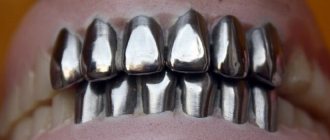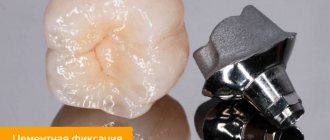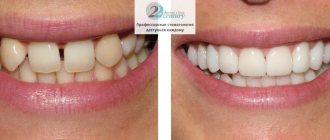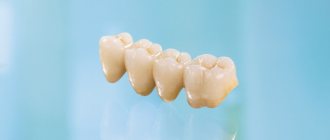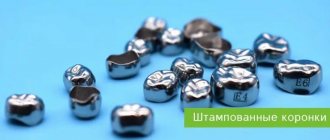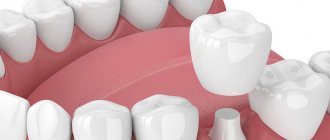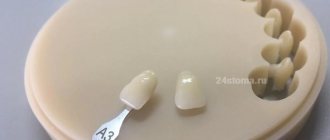Without exaggeration, zirconium crowns are a universal and technologically advanced orthopedic design. Strength and durability, like metal. And the aesthetics are like ceramic dentures. At the same time, dental crowns are comfortable and safe to wear, do not cause allergies, and do not harm the body.
In addition, a zirconium dioxide prosthesis can be installed on any dental unit - in the front row, on molars and premolars. The design is also suitable for fixing bridges of 2-3 teeth. Service life with proper use is from 10 to 15 years. Now more details.
Peculiarities
Modern prostheses are made from natural stone, zircon, which is white. Externally, the material resembles real teeth, and in terms of hardness and strength it is often compared to metal. Like everything natural, zirconium dioxide crowns are completely compatible with the human body, take root well and do not cause discomfort when worn constantly. Unlike metal ceramics, a zirconium prosthesis does not cause darkening of the gums, galvanism, and is suitable for people with high sensitivity to foreign materials.
The prosthesis is made using CAD/CAM computer technology - a painstaking and complex process that requires highly qualified doctors and dentists. This explains the high cost of the orthopedic design.
But if you look at the characteristics of zirconium crowns, it becomes clear that the investment is completely justified:
- The strength of the material is 2.5 times higher than that of ceramics (900-1000 MPa).
- The automated manufacturing process reduces the risk of errors, unlike manual production. The technology is so precise that often after installing crowns, additional grinding and turning of the prosthesis is not required.
- The aesthetic properties of a zircon prosthesis are slightly worse than porcelain crowns. They have lower capacity (less transparent). However, from the outside, it is difficult even for a specialist to distinguish zirconium crowns from real natural teeth.
Advantages and disadvantages of zirconium dental crowns
The advantages of zirconium crowns include:
- increased strength, resistance to mechanical loads is a very significant advantage; for this reason they are no worse, and sometimes even better, than metal ones;
- corrosion resistance;
- neutrality in relation to galvanic processes;
- free penetration of X-rays - they do not accumulate in zirconium during diagnostic studies;
- tight fit to the natural tissues of the destroyed unit, which gives the structure stability;
- natural aesthetic appearance is one of the main advantages;
- preparation of the unit in the process of preparation for prosthetics is carried out to a minimum extent, since the zirconium model is very thin;
- zirconium dioxide is fully compatible with human tissue and is highly hypoallergenic and does not cause allergic reactions - a very important advantage of the material;
- the prosthesis does not have increased thermal conductivity, so eating hot and cold food does not cause discomfort;
- Zirconium dioxide structures are the option of choice for implant prosthetics.
Disadvantages of zirconium crowns:
- the risk of accelerated abrasion of hard dental tissues on the opposite dentition - in order to smooth out this deficiency, it is not necessary to carry out prosthetics if the patient already has increased abrasion;
- the risk of chipping when porcelain coating the zirconium frame; because of this drawback, the models are not installed on chewing units;
- high price - metal-ceramic models are cheaper.
Varieties
The issue of aesthetics helps to decide the type of design and manufacturing method. There are classic and monolithic types of crowns.
In the first case, a zirconium base is used as a frame. And ceramics are applied on top in several layers. Thus, the design perfectly combines the strength of zircon and the impeccable aesthetics of ceramics.
Monolithic crowns are made from a single block, without additional cladding. But the mineral in its “pure form” has a milky tint, and differs from natural teeth. Therefore, monolithic zirconium crowns are used to restore chewing teeth.
The second type of prosthesis is more reliable, because eliminates possible chips on metal-free ceramics. To improve aesthetics, manufacturers began to produce colored zircon blocks (for example, Prettau technology). These crowns can be used to restore teeth in the smile area.
There is a material similar in external properties to zirconium dioxide - aluminum oxide. But the design is less durable, so it is used less often and only for prosthetics of the front teeth.
Content
- Zirconium – premium material
- Is it worth installing zirconium crowns?
- Features of crowns
- Indications for prosthetics
- Contraindications
- Stages
- Care of zirconium crowns
The front teeth are an area where aesthetics is extremely important. It is important that the crowns installed on the front teeth are beautiful, as natural in appearance and durable as possible. Zirconium is a modern high-tech material that allows you to brilliantly perform all these tasks.
Advantages of zirconium dioxide crowns
The popularity of zirconium crowns is due to many advantages.
The main thing is strength, which we have already talked about. Let us only add that the reliability of the prosthesis is confirmed by its use in complex bridge structures. The material is also used for prosthetics of the entire jaw, with complete or partial edentia. The second argument in favor of zircon is minimal grinding of the tooth when installing a prosthesis. The thickness of the crown is not at all large, so no more than 0.3-0.5 mm of enamel is removed from the supporting tooth. If the tooth is healthy and the pulp is not inflamed, then the dental nerve remains inside the tooth. This allows you to save your natural tooth for the maximum period, even if it is severely damaged.
Interestingly, throughout the entire period of use, zirconium dioxide crowns retain their external qualities. The surface of the prosthesis does not darken and is not subject to pigmentation. Zircon is also resistant to temperature changes, so the patient does not have a reaction to hot or cold food.
Making a prosthesis using digital technology ensures a tight fit of the internal cavity of the artificial tooth to the stump. This prevents the dental cement on which the prosthesis is attached from being washed out. As well as food getting and getting stuck inside the structure.
Metal-ceramic crown or zirconium crown – which is better?
To choose a material for prosthetics, you need to consult an orthopedic doctor. Which is better, a zirconium crown or a metal-ceramic crown, and what is their difference, can be seen from the following table:
| Prosthetic material | Metal ceramics | Zirconium |
| Appearance | Mediocre | All types of prostheses are aesthetic |
| Strength | There may be chips in the ceramics | Chips of ceramics with two-layer crowns |
| Fabric compatibility | Possible allergy or tissue irritation from metal | Fully compatible |
| Color change | Over time they acquire a grayish tint | Does not change color - a very important advantage |
| Preparation | A significant layer of enamel is removed, up to 2 mm | A very thin layer, up to 0.5 mm with a monolith and about 1 mm with a two-layer prosthesis |
| In what areas of the dentition are they installed? | On the sides. Not applicable for anterior areas due to color changes | In any area; Monolithic dentures are placed on the chewing units, with a ceramic coating on the anterior ones. |
| How suitable for implantation | There are contraindications | Ideal for implant prosthetics |
| Making a prosthesis | Mostly manually | Using computer technology on a robotic milling machine |
| Price | Average | Above average |
Cons of zirconium crowns
Prostheses made of zirconium are considered the most expensive among their analogues, in terms of the cost of material and manufacturing methods. In addition, the ceramic layer in the classic design of zirconium crowns is less durable. Chips may appear on the surface of the tooth, and the structure will have to be repaired or replaced.
The imperfection of aesthetics also falls into the “cons” column. Monolithic zirconium cannot convey the natural translucency of tooth enamel, so with a single tooth replacement it may look unnaturally white. However, if you restore the entire front row, there will be no problems with aesthetics.
Due to its strength, the material can wear away the enamel of neighboring teeth. The degree of abrasion is insignificant, but it is necessary to visit an orthopedic dentist periodically, once every six months, to prevent the destruction of healthy teeth.
Why do you need dentures?
Teeth must be restored in a timely manner, both partially destroyed and lost, and this must be done quickly, preferably within a year at most. Otherwise, a whole bunch of complications, including changes in bite, tilts and rotations of neighboring teeth, will ruin the dentition so much that prosthetics will be impossible without orthodontic preparation - i.e. special treatment with braces. You will first need to “disassemble the existing blockage” - create space for a crown, implant or “bridge” so that the dentures can fit into the dentition. And this, as you understand, is long, difficult and expensive. Read more about all the intricacies of prosthetics in the section Fixed prosthetics.
Production process
As mentioned above, zirconium dental crowns are made using CAD/CAM computer technology. The first part of the abbreviation stands for computer modeling of prostheses. And CAM is the subsequent milling of crowns according to the developed three-dimensional model.
In other words, “manual” intervention in the process is minimized. This eliminates possible errors in the production of the structure associated with the human factor.
The prosthesis manufacturing process consists of several stages:
- To transfer data to the program, the dentist scans the oral cavity with a special scanner. This is done immediately after treating the supporting teeth.
- The program develops a virtual model of the jaw with a new prosthesis. At the same time, the doctor selects the shade for the crown according to the Vita scale.
- Based on the calculations, a three-dimensional model of the prosthesis is created, according to which a zirconium dioxide crown will be made using a milling cutter.
- The finished product is subjected to heat treatment. If the prosthesis is two-layer, then the zirconium dioxide base is “baked” first, and then a second time after lining with ceramics.
At the final stage, the dentist paints the crown in the desired shade and transfers the structure to the dentist. Production of the prosthesis takes 1-2 weeks, depending on the complexity of production.
Manufacturing
CAD/CAM technology means that computer technology is involved in the manufacture of crowns. The process looks like this:
- intraoral scanning;
- creation of a three-dimensional model in front of the patient;
- machine calculation of shape and size;
- transfer of the project to a program-controlled milling machine;
- 3D printing.
There is no human factor. Therefore, zirconium crowns are characterized by increased precision.
To give a more natural look in the Dentistoff dental laboratory:
- take the patient’s photo protocol as a sample;
- remove the top millimeter from the front wall of the crown;
- facing material with variable transparency is applied layer by layer.
Zirconium makes it possible to work on the chewing surface and make it more comfortable for a particular person.
Installation of crowns
The procedure for fixing a zirconium dioxide crown to a tooth is standard. First, the doctor conducts an initial examination and diagnosis of the jaw to determine the condition of the oral cavity. If the patient requires preliminary treatment, the installation of the prosthesis is postponed until therapy is carried out.
If there are no pathologies, the dentist carries out professional teeth cleaning to remove soft and hard plaque. Then the doctor begins to grind the restored teeth. If the tooth is severely damaged, a pin, inlay or implant can be used as support.
If the root of the tooth is not damaged, then it is filled and the font is fixed on top. If the patient is allergic to metal, then a rod made of zirconium or titanium can be used. This method is not applicable in the presence of periodontal pathologies. And also in the presence of diseases of the nervous system.
The stump tab is also installed in the sealed root canal and ensures reliable fastening of the prosthesis. But the most common technique is fixing a zirconium crown to an implant. It is used when a tooth is missing. The titanium rod imitates a tooth root, preventing bone tissue atrophy. The material is biocompatible with the human body and fuses seamlessly with the jaw bone.
The process of attaching the crown to the supporting tooth or pin takes about 30 minutes. The structure is fixed with dental cement under the influence of light. Sometimes a so-called “temporary mixture” is used so that the patient can test the prosthesis as usual. If defects appear during wearing, the design is sent to the laboratory for revision. At the final stage, the zirconium crowns are placed on the support using dual-curing cement.
Zirconium is a premium material for prosthetics
Zirconium, or zircon, is a mineral salt of silicic acid. The dioxide is produced by chemically treating zirconium and enriching it with aluminum and yttrium. This allows you to achieve special strength. The result is a biocompatible material that is resistant to almost any damage. Advantages of zirconium crowns:
- Hypoallergenic, biocompatible.
- High aesthetics; a properly made crown is indistinguishable from a natural tooth.
- Durability.
- Strength.
- Computerized production of crowns, due to which the prosthesis fits perfectly and looks like a natural tooth.
Adaptation
The procedure for fixing zirconium crowns does not have a recovery period. The only restriction is not to eat food for 2-3 hours after installation of the prosthesis.
Of course, at first you may experience unusual sensations from the presence of a foreign structure in your mouth. There may be slight disturbances in diction, increased salivation, and discomfort in the facial muscles. As a rule, these sensations disappear after a few days, after the patient gets used to the new teeth. If discomfort persists or worsens, you should immediately consult a dentist. You should not try to straighten the structure yourself - this can lead to its breakdown and health problems.
Possible problems and complications
As a rule, if the installation protocol is strictly followed, there are no complications. Immediately after installing a zirconium prosthesis, you may experience discomfort, tension in the masticatory muscles, and minor problems with speech. All this goes away within a few days. But sometimes the following problems arise while wearing a prosthesis:
- Insufficient fit of the crown to the tooth is extremely rare, since computer technology implies high precision in making the model. This is where zirconium crowns differ significantly from metal-ceramics, since the fit accuracy of the latter is much less. And the larger the space between natural dental tissues and the prosthesis, the greater the risk of developing caries and loosening the structure. If such a complication occurs, the structure is removed, treatment and re-prosthetics are carried out.
- Caries and inflammation of the periodontal tissues may be associated with poor preparation for prosthetics. At the same time, the doctor decides whether the prosthesis needs to be removed or whether treatment can be carried out through a small hole in it.
You should consult a doctor if the following symptoms appear:
- redness and swelling of the gums near the denture;
- the tooth under the crown hurts a lot, chills and increased body temperature have joined in;
- loosening of the prosthesis.
Lifetime
A zirconia prosthesis does not have a fixed service life. On average, this is 10-15 years. With careful care and wear, crowns can last much longer. This depends on the condition of the teeth, the quality of the installation of the prosthesis and regular oral hygiene.
What can cause damage or damage to the structure:
- Lack of tightness. The reason is usually careless handling of the prosthesis, as well as poor quality material.
- Recession (exposed gums). Occurs due to inflammation in soft tissues. Or due to improper hygiene.
- Destruction of hard tooth tissues (periodontal disease, bruxism, inflammation).
Dental trauma caused by eating hard foods or lack of calcium in the body can also damage the prosthesis.
Contraindications
The restrictions on installing zirconium crowns are the same as with standard prosthetics. Contraindications include bruxism, the presence of inflammatory processes in the oral cavity in the body as a whole, and chronic diseases in the acute stage. As well as malocclusion, blood clotting disorders, and the rehabilitation period after surgery.
Price
| Included in the price |
|
| Paid separately |
|
| Affect size |
|
Rules of care
Although zirconia crowns are not susceptible to decay, deposits on the surface of artificial teeth can lead to damage to adjacent teeth, bad breath, and poor digestion.
In addition to brushing your teeth, it is recommended to use dental floss and irrigators to remove food debris in the interdental space. A special oral solution also helps get rid of bacteria.
Do not overuse very hard foods, do not crack the shells of nuts and seeds with your teeth. This may damage the surface of the prosthesis. Especially, the surface of zirconium crowns with ceramic veneer.
If you smoke, try to quit this habit. Tobacco leaves a yellow coating on the teeth that cannot be removed even by professional cleaning. In this case, the prosthesis will have to be changed after 2-3 years.
Visit your dentist's office every six months. The doctor will conduct professional oral hygiene and promptly identify the development of pathologies.
What are the pros and cons
Modern dentistry offers a wide selection of prostheses. They differ in several characteristics, including cost and durability. How do zirconium oxide crowns differ from other options? The products have many advantages, especially when compared with metal-ceramic ones, but there are also several disadvantages.
Advantages.
- Aesthetics. Light transparency and white tint make it possible to achieve impressive results.
- Maximum product fit. Crowns are made using modern technologies (computer sketching, production on special machines, etc.). Thanks to the tight fit, the risk of developing inflammation is reduced due to the penetration of microorganisms into the gap between the artificial material and the tissues.
- Hypoallergenic. Zirconium is a material characterized by absolute inertness. The development of allergies is excluded.
- Reliability and durability. Dentures are resistant to any external influences and can withstand even increased load on the dental structure. Their service life is on average 15 years.
- Eliminating the risk of decay of adjacent teeth. Zirconium crowns do not put pressure on other teeth.
- Resistance to deformation. Despite the thinness of the product, it does not deform under any influence and retains its shape throughout the entire period of operation.
If we talk about the disadvantages, then it is worth paying attention to the transparency of the prosthesis. The product may differ from other teeth when the natural color is not white, but, for example, with strong yellowness. When deciding on the color of the material, it is recommended to take into account that a phosphorus coating is often applied to the surface of the material, which can have different shades.
Despite the strength of the structure itself, there is always a risk of damage to the coating if porcelain cladding is used. Chips significantly reduce service life. Therefore, experts recommend installing solid-type structures on chewing teeth.
Another disadvantage is the risk of abrasion of the teeth of the opposite jaw. If the patient has a tendency to wear away tooth enamel, it is better to give preference to another type of prosthesis.
Price of zirconium crowns
The cost of zirconium crowns is influenced by the material, the chosen production and installation method, as well as the doctor’s qualifications. If the dentist chooses the method of prosthetics, then the responsibility for choosing a specialist lies on the shoulders of the patient. After all, your future health depends on who you entrust with dental treatment. Redoing someone else's poor-quality work is not only difficult, but also very expensive.
On average, the price of a zirconium dioxide prosthesis ranges from 15 thousand rubles and more. To receive qualified dental care, pay attention to whether the clinic has its own dental laboratory. And what equipment does a specialist use when producing a zirconium prosthesis?
At EspaDent clinics you can undergo a free initial diagnosis and find out the final cost of the procedure before treatment begins.
Advantages of dental prosthetics at the EspaDent clinic
- Diagnostics . At your service is a premium computer tomograph Sirona Ortophos SL 3D (Germany), which allows you to accurately plan treatment. The result of prosthetics can be assessed on the computer screen even before the manipulations begin.
- Implantation . The operation to install implants is quick and painless. The EspaDent clinic uses low-traumatic methods and uses 3D surgical templates.
- Manufacturing . Zirconium crowns are made in our laboratory, so the process takes a minimum of time. The latest CAD/CAM equipment operating in automatic mode is responsible for accuracy.
- Installation . We install permanent dentures with zirconium crowns on implants only after they are completely stabilized in the bone.
The article was checked by: Aivazov Tigran Georgievich
If you liked this post, share it with your friends and subscribers.
Factors for choosing a fixation method
The choice of the best fixation method for the patient is made by the doctor, based on their clinical picture, the main determining factors are:
- The total cost of treatment, the possible quality of the result and the financial requirements of the patient;
- Occlusal initial parameters;
- Potential risks of complications;
- Aesthetic requirements;
- Availability of access to the intervention area;
- Implant position;
- The need to maintain the structural elements of the prosthesis;
- Safety for the patient.
Based on the explanations of the attending physician, the patient consciously chooses or refuses to use this method.
It is preferable (ideally) to use screw fixation when installing implants in the lateral jaw, when the exit of the screw shaft is located in the center of the chewing surface. In the anterior part of the upper jaw, in cases where the implants have a vestibular inclination, the doctor determines based on the clinical situation which fixation is more convenient to use - cement fixation on individual abutments or using transocclusal screws.
